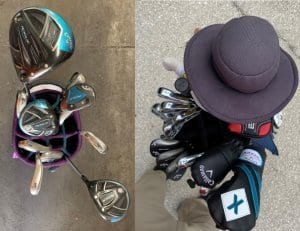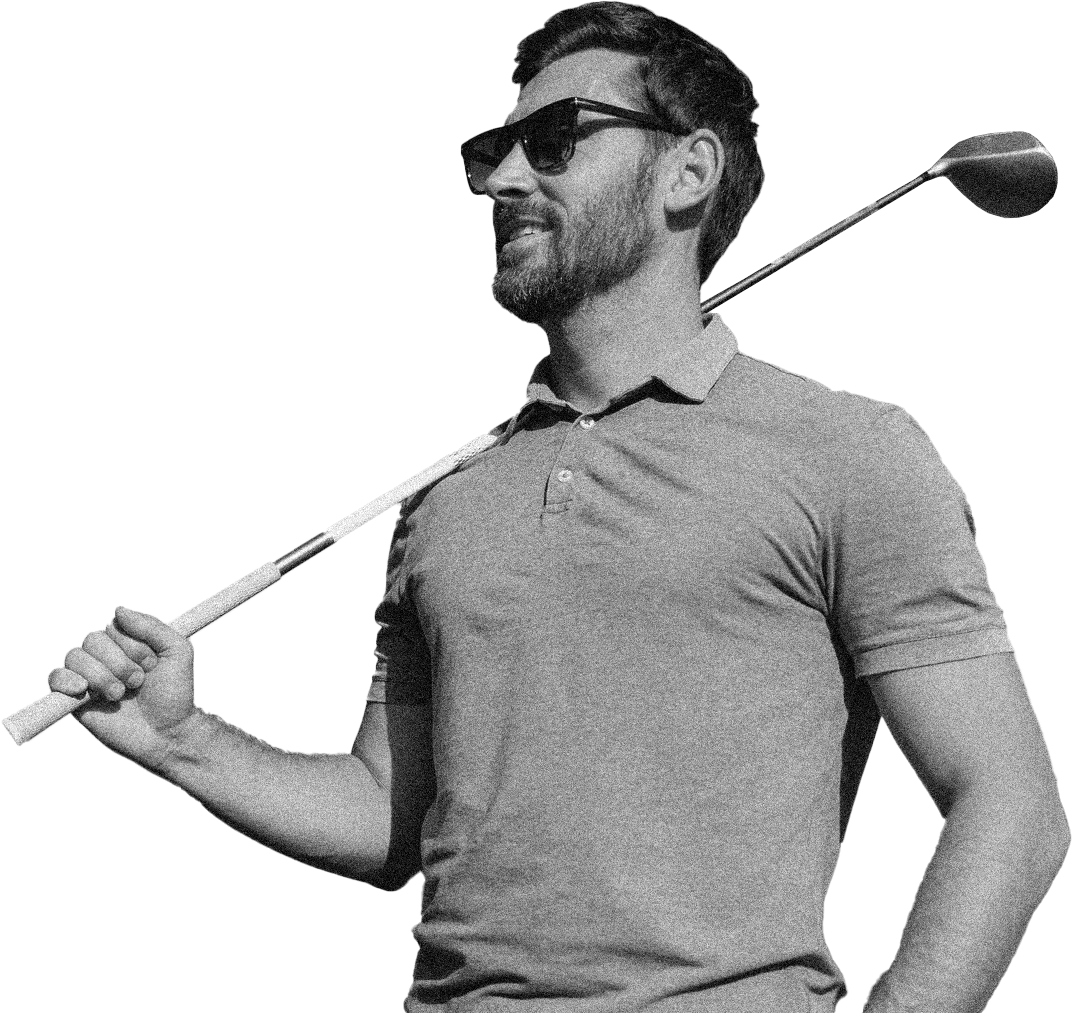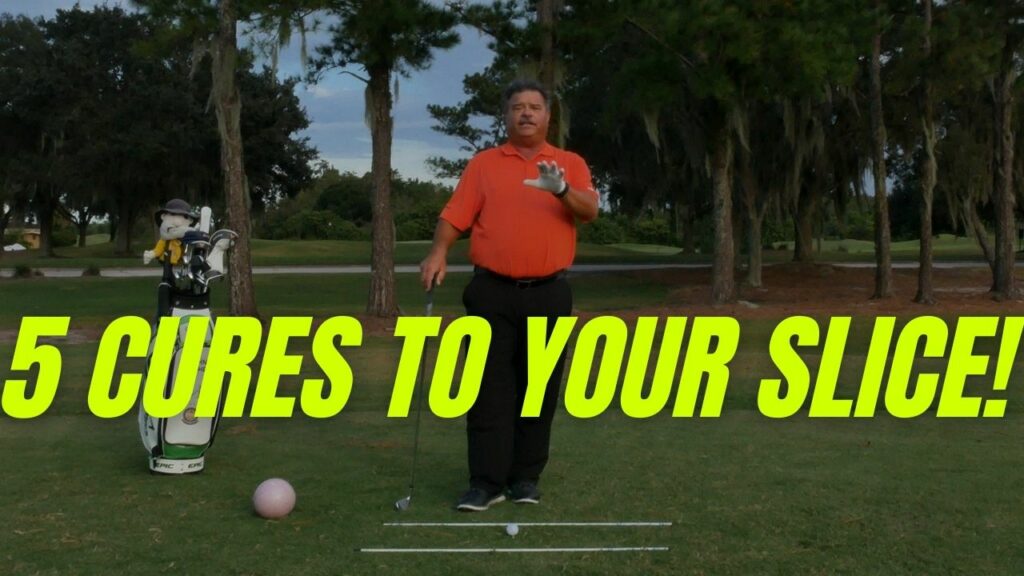Data from FlightScope and other data collection platforms show the most common ball flight among amateur golfers is a slice. I estimate almost 75% of my new clients ask me to help them fix their slice. Over the years, I’ve found 5 Simple Ways to Cure Your Slice. Each one independently can do so. Collectively, they go above and beyond the initial ask.
As you review these 5 Simple Ways to Cure Your Slice, remember that golf is counter-intuitive. Some of these fixes may not seem logical. To understand these fixes, realize that diagnosing your slice works backwards from the ball flight. I’ll take you in a more logical order of fixing your slice, versus attempting to ask you to do something you may not currently be capable of performing.
# 1 – Aim The Club Correctly
Sounds simple, and it is. Believe it or not, most slicers aim their golf club in the opposite direction of the slice. Sounds logical but its actually counter productive. Its more “reactive,” versus “proactive.” The more you aim the face in the opposite direction, the more likely your brain attempts to cure that position mid-swing. The mid-swing “compensation” typically creates a large than necessary outside to in swing path. This also increases the angle of attack of the club. The result? All 3 swing parameters at impact produce a club face that is open to your swing path. This causes you and the club face t cut across the ball at impact. In turn, creating a larger than desired spin axis with an excessive amount of spin, producing the slice.
How Do I Aim the Club Correctly to Cure Your Slice?
Always use the bottom of the club, or the “Leading Edge” to aim any club. Doing so insures you’re aiming all clubs, driver through putter, at your intended target. Never use the top line or face of the club, Doing so closes the club to your target. Your eyes will tell your brain the club is closed at address. Your brain in turn will attempt the compensation, needed or not.
# 2 – Aim Yourself Correctly
After aiming the club correctly, then aim yourself. Not the other way around.
In an effort to cure your slice, you like many golfers, are probably aiming your body first. If you’re using your front shoulder to aim your body to your intended target, you’ll likely aim the club back to the target. Or in other words, closed to your body. This is a direct result of aiming the body first, not second. The club hits the ball. You hold the club. Wouldn’t it make sense to aim the club first?
How do You Aim Your Body to Cure Your Slice?
Simply put, you aim the club first, using the leading edge. Aim towards a target just in front of the ball that sits on the line drawn from the target through the ball. Commonly referred to as the “target line,” you can then set you body up to the club. Only the club is required to properly aim. Your body reacts to where you aim the club. It is therefore likely that once your body has set up to the club, your body will set up on a “parallel left” line to the target line. Commonly referred to as the “body line,” this position places your anchor and your bend points (Feet, Knees, Hips, and Shoulders) in an efficient position to cure your slice.
#3 – Shift and Rotate
Most golfers who slice rotate and attempt to shift, in that order. This is not the way to cure your slice.
A well balanced golf swing that has great tempo actually does the opposite. As you make your back swing, you’ll shift your weight to the back of your swing. Your back leg “posts” to set the shift of weight. As the hips reach their maximum point of flexibility to “post up,” position, they begin to rotate to the front of the body. This rotation creates speed that is transferred to the upper body. The upper body is now forced to follow the rotational path of the lower body. Doing so provides the time and space required to square the club at impact more readily, reducing the chances of the club remaining open at impact.
Some golfers are limited by their flexibility to shift and rotate. Some golfers who slice can’t shift or rotate at all.
How do You Shift and Rotate to Cure Your Slice?
Its hard to learn to rotate while holding a club. That’s why I’ll have clients learn to rotate first, and incorporate holding the club after learning to rotate. The “Throw the Bag Drill” is a staple drill I use for those who have problems coordinating the proper shift and rotation of the body. Older golfers start losing the ability to rotate. This is why I’ll also ask clientele to do this drill at home on a regular basis. Not only will this drill cure your slice, it can lead to increased distances as well. Ask Ed if you don’t believe me.
#4 – Create Forward Shaft Lean
All clubs are designed in such a way as to create a slight lean of the handle forward, in front of where the club lays on the ground. Ideally, replicating, or even increasing the forward lean of the shaft at impact, can cure your slice. It can also exponentially increase the distance you hit each club.
If the handle of the club is behind the club at impact, chances are it is also open to the target. The increase in loft produces higher than desired shots. While the open club face produces the excessive side spin you’re trying to eliminate.
How to Cure Your Slice with Forward Shaft Lean
If you can keep your front wrist flatter, longer, through impact, you have a good chance to cure your slice. Drills such as the “Drag the Stick” drill, as well as hitting an Impact Bag can provide the feeling of keeping your front wrist flatter at impact.
#5 – Learn to Release the Club
Many times a slice is caused by your failure to release the club. Doing so can open the face severely at impact, sometimes causing the other dreaded “S” word, the shank. Hosel rockets can happen when the bottom hand on the grip over dominates, slowing the club down as it approaches impact, leaving the face wide open. Deceleration and a lack of release will not cure your slice. But those two things can lead to complete frustration, if the other 4 fixes are in place.
What you have to realize in this example is the club was most likely released in part, or in full, prior to its arrival to the ball. In most instances, its a partial release that you try to correct on the way down. Doing so only exasperates the issue.
Releasing the Club to Cure Your Slice is Multi-Faceted
There are several great drills to assist you with learning what a proper release of the club should feel like. The most important feeling each should provide is the club holding a forward shaft lean at impact and allowing the club to release through the ball, not before.
Swinging a club with your feet separated by just a couple inches will provide this feeling, so long as you allow a little rotation to occur as you make the downswing. You can also use the bottom hand only to hit shots. This produces a position and feeling that does not prematurely release the club, while giving the bottom hand to learn its role without interference from the top hand. If you do this drill, be sure to place both hands on the club first. Then take the top hand off. This insures the bottom hand is in the correct place on the handle.
Watch the Video to Cure Your Slice
Conclusion
There are other ways to cure your slice, as there are many ways to peel a banana. In attempting to sure your slice, start with the path of least resistance first. You’ve probably been doing the opposite. Insure your aim and set up positions are sound. Doing so creates a more repeatable swing. In turn, a more repeatable swing is easier diagnosed and easier to provide relief.
Why not visit me this spring for a golf school and learn these 5 ways and more to cure your slice?






